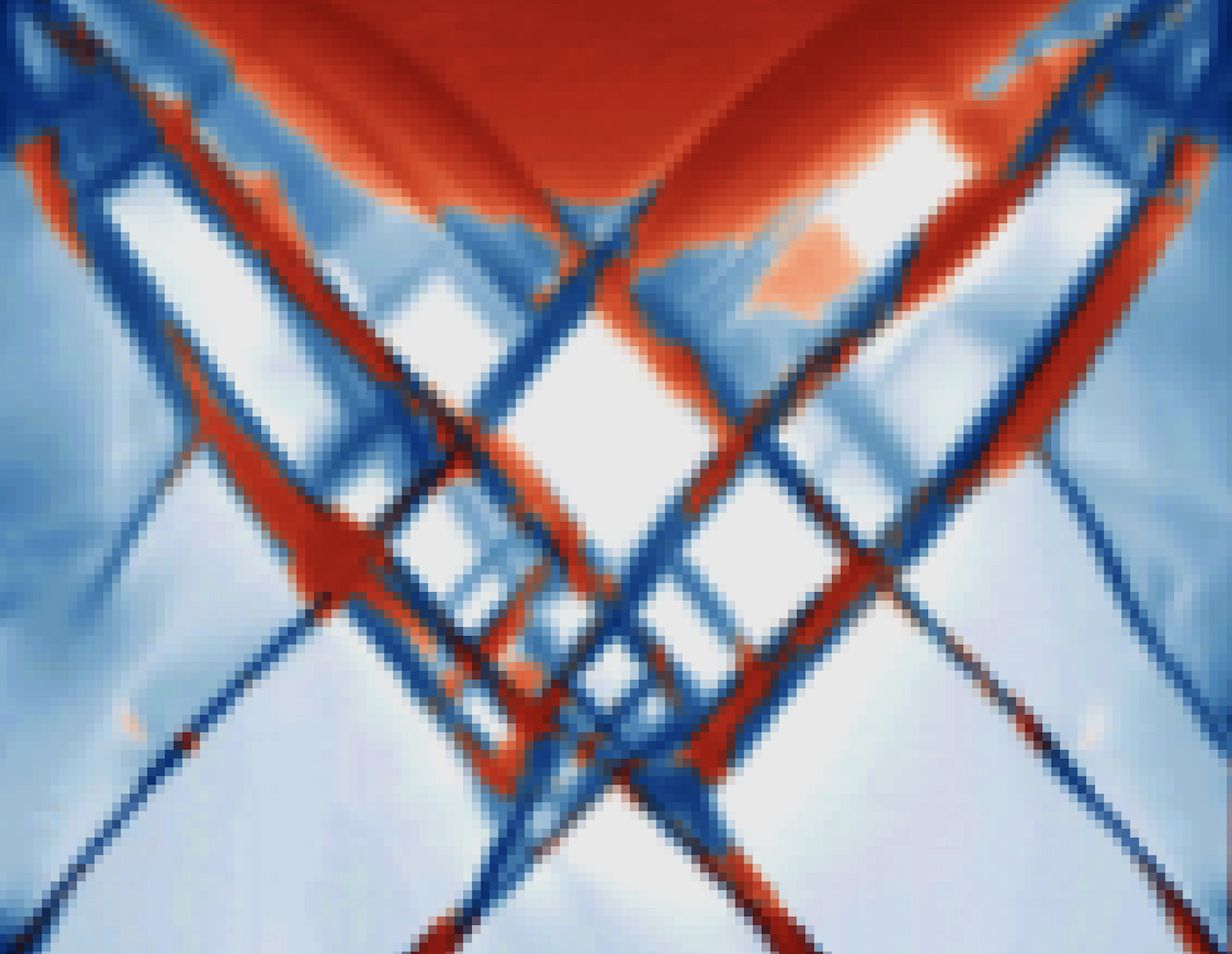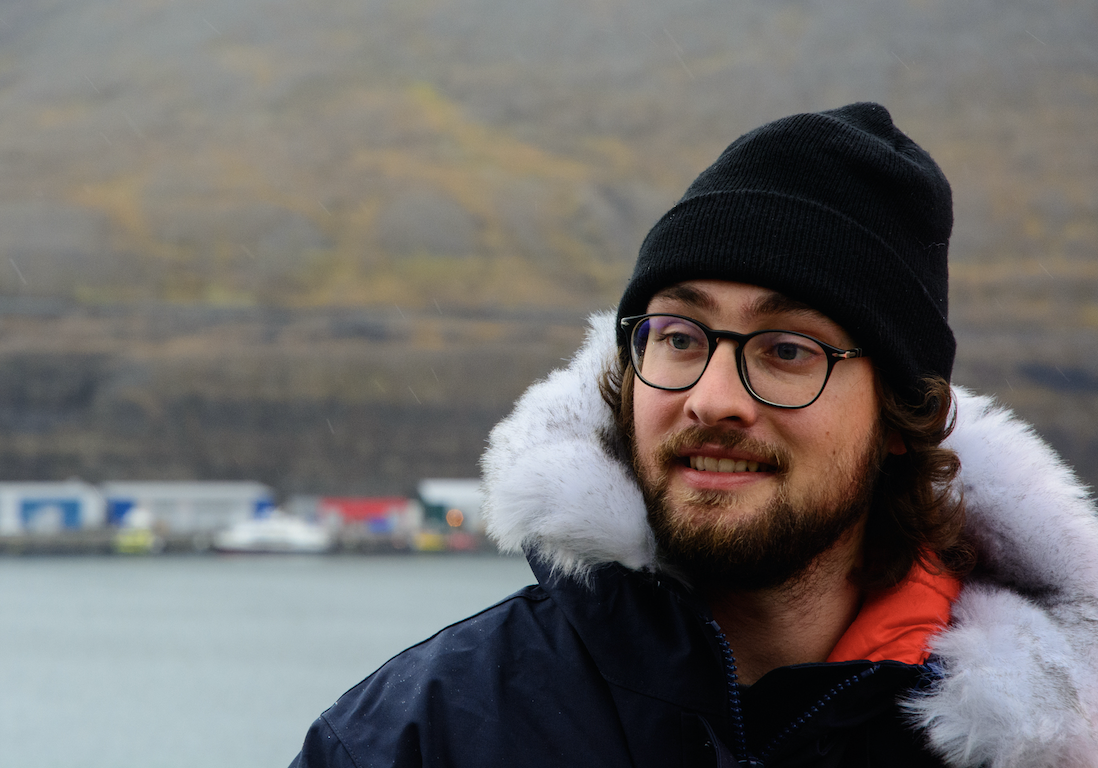
Researchers from Germany and Canada study fracturing of sea ice by comparing different rheologies in the MITgcm sea-ice package.
Reporting by Helen Hill for MITgcm

Under the constant agitation of waves and wind, sea ice tends to be rather granular in nature, composed of ice floes of different sizes and shapes. In most large-scale models, sea ice is treated as a viscous–plastic continuum, deforming plastically when the internal stress becomes critical in compression, shear, or tension; creeping viscously when the internal stress is relatively small.
While recent high-resolution pan-Arctic simulations have been developed to include sea-ice fracturing, the models produce wider fracture angles than those seen in high-resolution satellite images. Getting sea-ice fracturing wrong in such simulations can lead (no pun intended) to changes in the subsequent dynamics, mass balance, and the heat and matter exchanges between the ocean, ice, and atmosphere.

Lead author Damien Ringeisen has been using MITgcm since he started his PhD in October 2016. He says, when the weather is fair enough, he enjoys spending time outside in a large community garden. Image credit: Ryan Love.
Motivated by this, Damien Ringeisen, Martin Losch, and Nils Hutter from the Alfred-Wegner Institute of the Helmholtz Zentrum fur Polar und Meeresforschung (AWI) Bremerhaven Germany working with Bruno Tremblay from the Department of Atmospheric and Oceanic Sciences, McGill University, Montreal, Canada, set about exploring what might be causing this discrepancy, work that was recently published in journal The Cryosphere.
To investigate whether sea ice fracture is represented accurately in continuum sea ice models, Ringeisen et al used MITgcm, the sea-ice package of which allows for use of different rheologies – alternative prescriptions for how the sea-ice should respond to an applied force.
The team set up a simple uni-axial loading test, to compare the response of an ideal section of sea-ice 8 km by 25 km to compression using two different mathematical expressions defining the ice’s resistance to the compressive force, one with an elliptical yield curve and a normal flow rule (the most common rheology used to describe sea-ice behavior) and the other with a Coulombic yield curve and a normal flow rule applying only to the elliptical part of the ice cap.
The authors report that although at first sight, the large-scale patterns appear realistic when compared to satellite observations, the standard rheology overpredicted fracture angle and showed results that were often in opposition with ice’s granular nature. However, the alternative rheology they tried, although it yielded a fracture angle closer to the observations, introduced unwelcome instabilities.
To find out more about this work contact Damien
This Month’s Featured Publication
- Damien Ringeisen, Martin Losch, L. Bruno Tremblay, and Nils Hutter (2019), Simulating intersection angles between conjugate faults in sea ice with different viscous–plastic rheologies, The Cryosphere, doi: 10.5194/tc-13-1167-2019
Related Publication
Martin Losch, Dimitris Menemenlis, Jean-Michel Campin, Patick Heimbach, Chris Hill (2010), On the formulation of sea-ice models. Part 1: Effects of different solver implementations and parameterizations, Ocean Modelling, doi: 10.1016/j.ocemod.2009.12.008
Other New Publications this Month
Assimina Antonarakou, George Kontakiotis, Aristomenis P. Karageorgis, Eva Besiou, Stergios Zarkogiannis, Hara Drinia, Graham P. Mortyn, Eftymis Tripsanas
(2019), Eco-biostratigraphic advances in late Quaternary geochronology and palaeoclimate: the marginal Gulf of Mexico analogue, Geological Quarterly, doi: 10.7306/gq.1457
Jacob Arcangeli, Jean-Michel Désert, Vivien Parmentier, Kevin B. Stevenson, Jacob L. Bean, Michael R. Line, Laura Kreidberg, Jonathan J Fortney, Adam P. Showman (2019), Climate of an Ultra Hot Jupiter Spectroscopic phase curve of WASP-18b with HST/WFC3, arXiv:1904.02069 [astro-ph.EP]
Cheng Chen, Bo Lei, Yuanliang Ma, Ying Liu, Yang Wang (2019), Diurnal Fluctuation of Shallow-Water Acoustic Propagation in the Cold Dome Off Northeastern Taiwan in Spring, IEEE Journal of Oceanic Engineering, doi: 10.1109/JOE.2019.2902199
Mara A Freilich, and Amala Mahadevan (2019), Decomposition of vertical velocity for nutrient transport in the upper ocean, Journal of Physical Oceanography, doi: 10.1175/JPO-D-19-0002.1
Jiaoqi Fu, Chao Chen, Yanli Chu (2019), Spatial–temporal variations of oceanographic parameters in the Zhoushan sea area of the East China Sea based on remote sensing datasets, Regional Studies of Marine Science, doi: 10.1016/j.rsma.2019.100626
Yankun Gong, Matthew D. Rayson, Nicole L. Jones, and Gregory N. Ivey (2019), The effects of remote internal tides on continental slope internal tide generation, Journal of Physical Oceanography, doi: 10.1175/JPO-D-18-0180.1
Mukund Gupta, John Marshall, and David Ferreira (2019), Triggering global climate transitions through volcanic eruptions, Journal of Climate, doi: 10.1175/JCLI-D-18-0883.1
Thaddeus D. Komacek, Adam P. Showman, and Vivien Parmentier (2019), Vertical Tracer Mixing in Hot Jupiter Atmospheres, arXiv:1904.09676 [astro-ph.EP]
Jozef I. Nissimov, David Talmy, Liti Haramaty, Helen Fredricks, Ehud Zelzion, Benjamin Knowles, Murat Eren, Rebecca Vandzura, Christien P. Laber, Brittany M. Schieler, Christopher T. Johns, Kuldeep More, Marco J.L. Coolen, Michael J. Follows, Debashish Bhattacharya, Benjamin A.S. Van Mooy, Kay D. Bidle (2019), Biochemical diversity of glycosphingolipid biosynthesis as a driver of Coccolithovirus competitive ecology, Environmental Microbiology, doi: 10.1111/1462-2920.14633
Nadia Pinardi, Paola Cessi, Federica Borile, Christopher L.P. Wolfe (2019), The Mediterranean Sea Overturning Circulation, doi: 10.1175/JPO-D-18-0254.1
Larry J. Pratt, Gunnar Voet, Astrid Pacini, Shuwen Tan, Matthew H. Alford, Glenn S. Carter, James B. Girton, and Dimitris Menemenlis (2019), Pacific abyssal transport and mixing: through the Samoan Passage vs. around the Manihiki Plateau, Journal of Physical Oceanography, doi: 10.1175/JPO-D-18-0124.1
Yu-Kun Qian, Shiqiu Peng, and Chang-Xia Liang (2019), Reconciling Lagrangian Diffusivity and Effective Diffusivity in Contour-Based Coordinates, Journal of Physical Oceanography, doi: 10.1175/JPO-D-18-0251.1
S. M. Reckinger, et al. (2019), The Effect of Numerical Parameters on Eddies in Oceanic Overflows: A laboratory and numerical study, Int. J. Comp. Meth. and Exp. Meas., Vol. 7, No. 2 (2019) 142–153, https://www.witpress.com/Secure/ejournals/papers/CMEM070205f.pdf
Jianfen Wei, Xiangdong ZhangEmail authorZhaomin Wang (2019), Reexamination of Fram Strait sea ice export and its role in recently accelerated Arctic sea ice retreat, Climate Dynamics, doi: 10.1007/s00382-019-04741-0
Qinghua Yang, Longjiang Mu, Xingren Wu, Jiping Liu, Fei Zheng, Jinlun Zhang, Chuanjin Li (2019), Improving Arctic sea ice seasonal outlook by ensemble prediction using an ice-ocean model, Atmospheric Research, doi: 10.1016/j.atmosres.2019.04.021
Xiaolong Yu and Alberto C. Naveira Garabato (2019), An Annual Cycle of Submesoscale Vertical Flow and Restratification in the Upper Ocean, Journal of Physical Oceanography, doi: 10.1175/JPO-D-18-0253.1
Ruifeng Zhang, Rachel L. Kelly, Kathryn M. Kauffman, Amber K. Reid, Jonathan M. Lauderdale, Michael J. Follows, Seth G. John (2019), Growth of marine Vibrio in oligotrophic environments is not stimulated by the addition of inorganic iron, Earth and Planetary Science Letters, doi: 10.1016/j.epsl.2019.04.002
Yanxu Zhang, Hannah Horowitz, Jiancheng Wang, Zhouqing Xie, Joachim Kuss, and Anne L. Soerensen (2019), A Coupled Global Atmosphere-Ocean Model for Air-Sea Exchange of Mercury: Insights into Wet Deposition and Atmospheric Redox Chemistry, Environmental Sciences and Technology, doi: 10.1021/acs.est.8b06205
Zhongxiang Zhao, Jinbo Wang, Dimitris Menemenlis, Lee-Lueng Fu, Shuiming Chen and Bo Qiu (2019), Decomposition of the multimodal multidirectional M2 internal tide field, Journal of Atmospheric and Oceanic Technology, doi: 10.1175/JTECH-D-19-0022.1
Do you have news about research using MITgcm? We are looking for contributions to these pages. If you have an interesting MITgcm project (ocean, atmosphere, sea-ice, physics, biology or otherwise) that you want to tell people about, get in touch. To make a post, contact Helen
